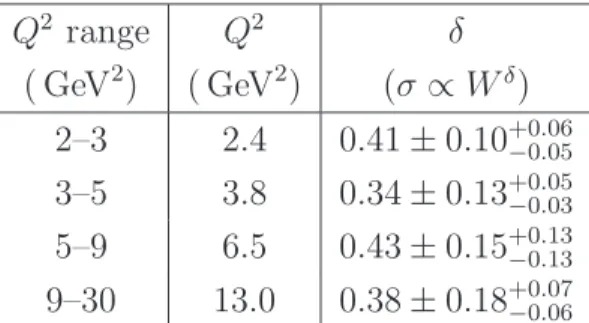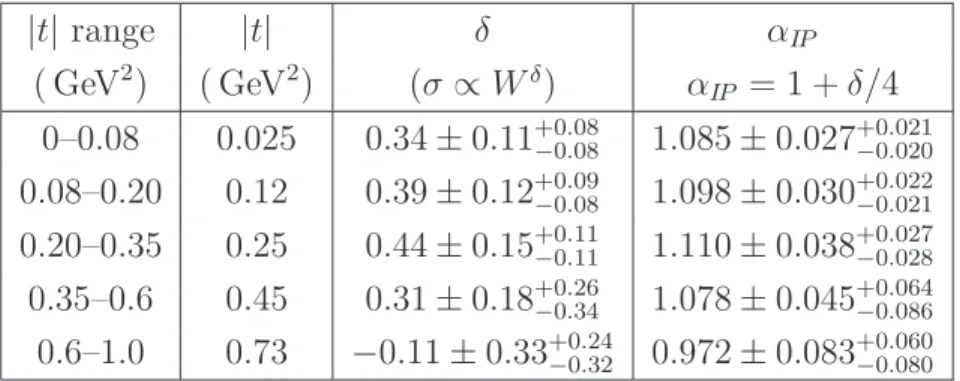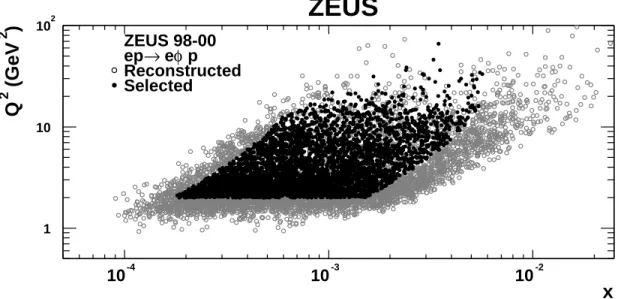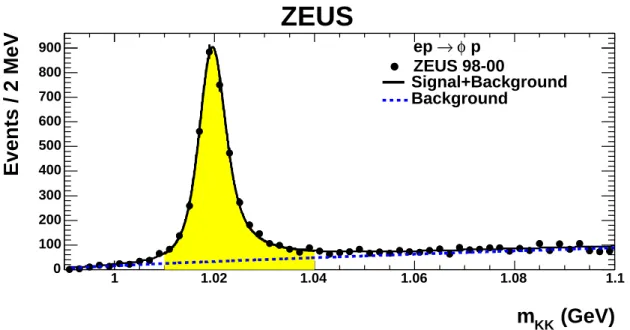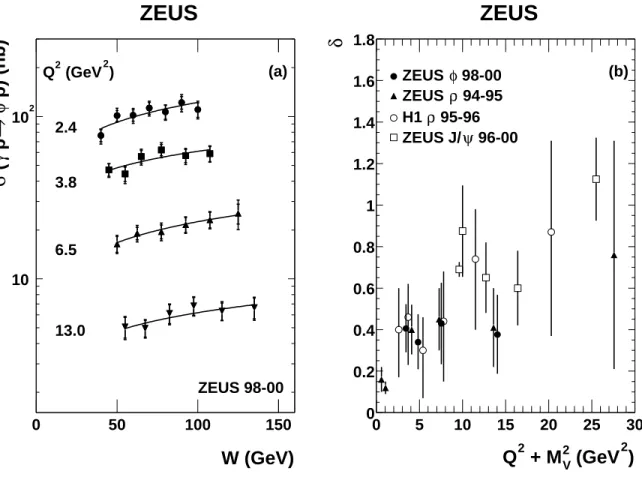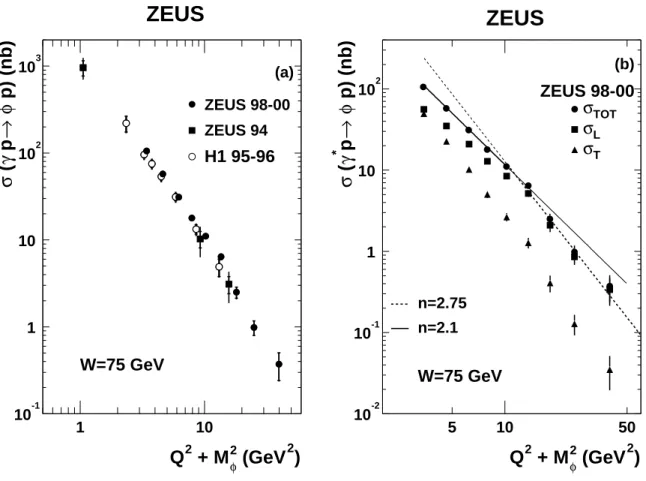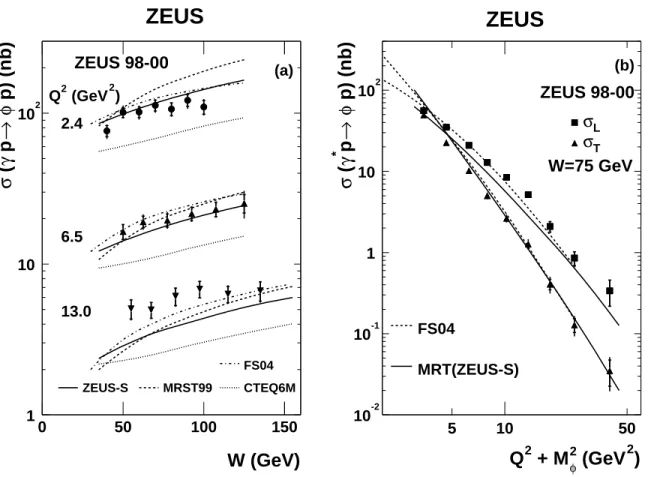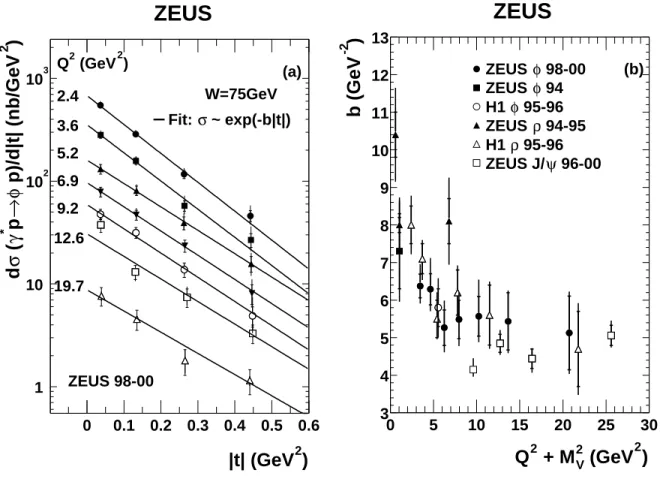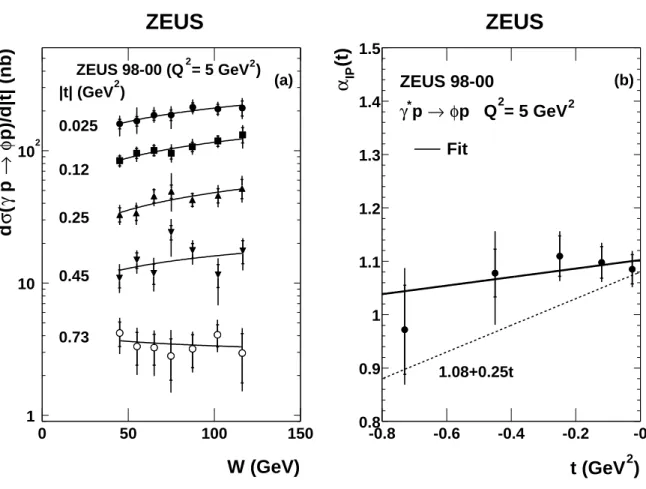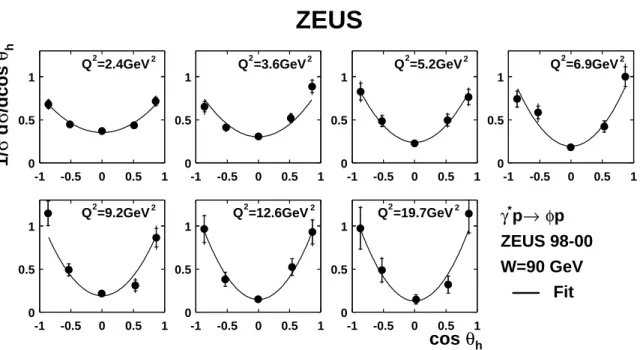arXiv:hep-ex/0504010 v1 7 Apr 2005
DESY 05-038 October 19, 2005
Exclusive electroproduction of φ mesons at HERA
ZEUS Collaboration
Abstract
Exclusive electroproduction of φ mesons has been studied in e±p collisions at
√s= 318 GeV with the ZEUS detector at HERA using an integrated luminosity of 65.1 pb−1. Theγ∗pcross section is presented in the kinematic range 2< Q2 <
70 GeV2, 35< W <145 GeV and |t|<0.6 GeV2. The cross sections as functions of Q2, W,t and helicity angle θh are compared to cross sections for other vector mesons. The ratios R of the cross sections for longitudinally and transversely polarized virtual photons are presented as functions of Q2 and W. The data are also compared to predictions from theoretical models.
The ZEUS Collaboration
S. Chekanov, M. Derrick, S. Magill, S. Miglioranzi1, B. Musgrave, J. Repond, R. Yoshida Argonne National Laboratory, Argonne, Illinois 60439-4815, USA n
M.C.K. Mattingly
Andrews University, Berrien Springs, Michigan 49104-0380, USA N. Pavel, A.G. Yag¨ues Molina
Institut f¨ur Physik der Humboldt-Universit¨at zu Berlin, Berlin, Germany
P. Antonioli, G. Bari, M. Basile, L. Bellagamba, D. Boscherini, A. Bruni, G. Bruni, G. Cara Romeo, L. Cifarelli, F. Cindolo, A. Contin, M. Corradi, S. De Pasquale, P. Giusti, G. Iacobucci, A. Margotti, A. Montanari, R. Nania, F. Palmonari, A. Pesci, A. Polini, L. Rinaldi, G. Sartorelli, A. Zichichi
University and INFN Bologna, Bologna, Italye
G. Aghuzumtsyan, D. Bartsch, I. Brock, S. Goers, H. Hartmann, E. Hilger, P. Irrgang, H.-P. Jakob, O.M. Kind, U. Meyer, E. Paul2, J. Rautenberg, R. Renner, K.C. Voss3, M. Wang, M. Wlasenko
Physikalisches Institut der Universit¨at Bonn, Bonn, Germanyb
D.S. Bailey4, N.H. Brook, J.E. Cole, G.P. Heath, T. Namsoo, S. Robins
H.H. Wills Physics Laboratory, University of Bristol, Bristol, United Kingdomm M. Capua, S. Fazio, A. Mastroberardino, M. Schioppa, G. Susinno, E. Tassi Calabria University, Physics Department and INFN, Cosenza, Italye
J.Y. Kim, K.J. Ma5
Chonnam National University, Kwangju, South Koreag M. Helbich, Y. Ning, Z. Ren, W.B. Schmidke, F. Sciulli
Nevis Laboratories, Columbia University, Irvington on Hudson, New York 10027o J. Chwastowski, A. Eskreys, J. Figiel, A. Galas, K. Olkiewicz, P. Stopa, D. Szuba, L. Za- wiejski
Institute of Nuclear Physics, Cracow, Poland i
L. Adamczyk, T. Bo ld, I. Grabowska-Bo ld, D. Kisielewska, A.M. Kowal, J. Lukasik, M. Przybycie´n, L. Suszycki, J. Szuba6
Faculty of Physics and Applied Computer Science, AGH-University of Science and Tech- nology, Cracow, Poland p
A. Kota´nski7, W. S lomi´nski
Department of Physics, Jagellonian University, Cracow, Poland
V. Adler, U. Behrens, I. Bloch, K. Borras, G. Drews, J. Fourletova, A. Geiser, D. Gladkov, P. G¨ottlicher8, O. Gutsche, T. Haas, W. Hain, C. Horn, B. Kahle, U. K¨otz, H. Kowal- ski, G. Kramberger, D. Lelas9, H. Lim, B. L¨ohr, R. Mankel, I.-A. Melzer-Pellmann, C.N. Nguyen, D. Notz, A.E. Nuncio-Quiroz, A. Raval, R. Santamarta, U. Schneekloth, H. Stadie, U. St¨osslein, G. Wolf, C. Youngman, W. Zeuner
Deutsches Elektronen-Synchrotron DESY, Hamburg, Germany S. Schlenstedt
Deutsches Elektronen-Synchrotron DESY, Zeuthen, Germany G. Barbagli, E. Gallo, C. Genta, P. G. Pelfer
University and INFN, Florence, Italy e
A. Bamberger, A. Benen, F. Karstens, D. Dobur, N.N. Vlasov10
Fakult¨at f¨ur Physik der Universit¨at Freiburg i.Br., Freiburg i.Br., Germany b
P.J. Bussey, A.T. Doyle, W. Dunne, J. Ferrando, J. Hamilton, D.H. Saxon, I.O. Skillicorn Department of Physics and Astronomy, University of Glasgow, Glasgow, United King- dom m
I. Gialas11
Department of Engineering in Management and Finance, Univ. of Aegean, Greece T. Carli12, T. Gosau, U. Holm, N. Krumnack13, E. Lohrmann, M. Milite, H. Salehi, P. Schleper, T. Sch¨orner-Sadenius, S. Stonjek14, K. Wichmann, K. Wick, A. Ziegler, Ar. Ziegler
Hamburg University, Institute of Exp. Physics, Hamburg, Germany b
C. Collins-Tooth15, C. Foudas, C. Fry, R. Gon¸calo16, K.R. Long, A.D. Tapper
Imperial College London, High Energy Nuclear Physics Group, London, United King- dom m
M. Kataoka17, K. Nagano, K. Tokushuku18, S. Yamada, Y. Yamazaki Institute of Particle and Nuclear Studies, KEK, Tsukuba, Japan f A.N. Barakbaev, E.G. Boos, N.S. Pokrovskiy, B.O. Zhautykov
Institute of Physics and Technology of Ministry of Education and Science of Kazakhstan, Almaty, Kazakhstan
D. Son
Kyungpook National University, Center for High Energy Physics, Daegu, South Korea g J. de Favereau, K. Piotrzkowski
Institut de Physique Nucl´eaire, Universit´e Catholique de Louvain, Louvain-la-Neuve, Bel- gium q
F. Barreiro, C. Glasman19, M. Jimenez, L. Labarga, J. del Peso, J. Terr´on, M. Zambrana Departamento de F´ısica Te´orica, Universidad Aut´onoma de Madrid, Madrid, Spain l F. Corriveau, C. Liu, M. Plamondon, A. Robichaud-Veronneau, R. Walsh, C. Zhou Department of Physics, McGill University, Montr´eal, Qu´ebec, Canada H3A 2T8a T. Tsurugai
Meiji Gakuin University, Faculty of General Education, Yokohama, Japanf
A. Antonov, B.A. Dolgoshein, I. Rubinsky, V. Sosnovtsev, A. Stifutkin, S. Suchkov Moscow Engineering Physics Institute, Moscow, Russia j
R.K. Dementiev, P.F. Ermolov, L.K. Gladilin, I.I. Katkov, L.A. Khein, I.A. Korzhav- ina, V.A. Kuzmin, B.B. Levchenko, O.Yu. Lukina, A.S. Proskuryakov, L.M. Shcheglova, D.S. Zotkin, S.A. Zotkin
Moscow State University, Institute of Nuclear Physics, Moscow, Russiak I. Abt, C. B¨uttner, A. Caldwell, X. Liu, J. Sutiak
Max-Planck-Institut f¨ur Physik, M¨unchen, Germany
N. Coppola, G. Grigorescu, A. Keramidas, E. Koffeman, P. Kooijman, E. Maddox, H. Tiecke, M. V´azquez, L. Wiggers
NIKHEF and University of Amsterdam, Amsterdam, Netherlands h N. Br¨ummer, B. Bylsma, L.S. Durkin, T.Y. Ling
Physics Department, Ohio State University, Columbus, Ohio 43210n
P.D. Allfrey, M.A. Bell, A.M. Cooper-Sarkar, A. Cottrell, R.C.E. Devenish, B. Foster, G. Grzelak, C. Gwenlan20, T. Kohno, S. Patel, P.B. Straub, R. Walczak
Department of Physics, University of Oxford, Oxford United Kingdom m
P. Bellan, A. Bertolin, R. Brugnera, R. Carlin, R. Ciesielski, F. Dal Corso, S. Dusini, A. Garfagnini, S. Limentani, A. Longhin, L. Stanco, M. Turcato
Dipartimento di Fisica dell’ Universit`a and INFN, Padova, Italye E.A. Heaphy, F. Metlica, B.Y. Oh, J.J. Whitmore21
Department of Physics, Pennsylvania State University, University Park, Pennsylvania 16802o
Y. Iga
Polytechnic University, Sagamihara, Japanf G. D’Agostini, G. Marini, A. Nigro
Dipartimento di Fisica, Universit`a ’La Sapienza’ and INFN, Rome, Italye J.C. Hart
Rutherford Appleton Laboratory, Chilton, Didcot, Oxon, United Kingdom m
H. Abramowicz22, A. Gabareen, S. Kananov, A. Kreisel, A. Levy
Raymond and Beverly Sackler Faculty of Exact Sciences, School of Physics, Tel-Aviv University, Tel-Aviv, Israel d
M. Kuze
Department of Physics, Tokyo Institute of Technology, Tokyo, Japan f S. Kagawa, T. Tawara
Department of Physics, University of Tokyo, Tokyo, Japan f
R. Hamatsu, H. Kaji, S. Kitamura23, K. Matsuzawa, O. Ota, Y.D. Ri Tokyo Metropolitan University, Department of Physics, Tokyo, Japan f M. Costa, M.I. Ferrero, V. Monaco, R. Sacchi, A. Solano
Universit`a di Torino and INFN, Torino, Italy e M. Arneodo, M. Ruspa
Universit`a del Piemonte Orientale, Novara, and INFN, Torino, Italy e S. Fourletov, J.F. Martin
Department of Physics, University of Toronto, Toronto, Ontario, Canada M5S 1A7 a J.M. Butterworth24, R. Hall-Wilton, T.W. Jones, J.H. Loizides25, M.R. Sutton4, C. Targett- Adams, M. Wing
Physics and Astronomy Department, University College London, London, United King- dom m
J. Ciborowski26, P. Kulinski, P. Lu˙zniak27, J. Malka27, R.J. Nowak, J.M. Pawlak, J. Sztuk28, T. Tymieniecka, A. Tyszkiewicz27, A. Ukleja, J. Ukleja29, A.F. ˙Zarnecki
Warsaw University, Institute of Experimental Physics, Warsaw, Poland M. Adamus, P. Plucinski
Institute for Nuclear Studies, Warsaw, Poland
Y. Eisenberg, D. Hochman, U. Karshon, M.S. Lightwood
Department of Particle Physics, Weizmann Institute, Rehovot, Israelc
E. Brownson, T. Danielson, A. Everett, D. K¸cira, S. Lammers, L. Li, D.D. Reeder, M. Rosin, P. Ryan, A.A. Savin, W.H. Smith
Department of Physics, University of Wisconsin, Madison, Wisconsin 53706, USAn S. Dhawan
Department of Physics, Yale University, New Haven, Connecticut 06520-8121, USA n S. Bhadra, C.D. Catterall, Y. Cui, G. Hartner, S. Menary, U. Noor, M. Soares, J. Standage, J. Whyte
Department of Physics, York University, Ontario, Canada M3J 1P3 a
1 also affiliated with University College London, UK
2 retired
3 now at the University of Victoria, British Columbia, Canada
4 PPARC Advanced fellow
5 supported by a scholarship of the World Laboratory Bj¨orn Wiik Research Project
6 partly supported by Polish Ministry of Scientific Research and Information Technology, grant no.2P03B 12625
7 supported by the Polish State Committee for Scientific Research, grant no. 2 P03B 09322
8 now at DESY group FEB, Hamburg, Germany
9 now at LAL, Universit´e de Paris-Sud, IN2P3-CNRS, Orsay, France
10 partly supported by Moscow State University, Russia
11 also affiliated with DESY
12 now at CERN, Geneva, Switzerland
13 now at Baylor University, USA
14 now at University of Oxford, UK
15 now at the Department of Physics and Astronomy, University of Glasgow, UK
16 now at Royal Holloway University of London, UK
17 also at Nara Women’s University, Nara, Japan
18 also at University of Tokyo, Japan
19 Ram´on y Cajal Fellow
20 PPARC Postdoctoral Research Fellow
21 on leave of absence at The National Science Foundation, Arlington, VA, USA
22 also at Max Planck Institute, Munich, Germany, Alexander von Humboldt Research Award
23 present address: Tokyo Metropolitan University of Health Sciences, Tokyo 116-8551, Japan
24 also at University of Hamburg, Germany, Alexander von Humboldt Fellow
25 partially funded by DESY
26 also at L´od´z University, Poland
27 L´od´z University, Poland
28 L´od´z University, Poland, supported by the KBN grant 2P03B12925
29 supported by the KBN grant 2P03B12725
a supported by the Natural Sciences and Engineering Research Council of Canada (NSERC)
b supported by the German Federal Ministry for Education and Research (BMBF), under contract numbers HZ1GUA 2, HZ1GUB 0, HZ1PDA 5, HZ1VFA 5
c supported in part by the MINERVA Gesellschaft f¨ur Forschung GmbH, the Israel Science Foundation (grant no. 293/02-11.2), the U.S.-Israel Binational Science Foundation and the Benozyio Center for High Energy Physics
d supported by the German-Israeli Foundation and the Israel Science Foundation
e supported by the Italian National Institute for Nuclear Physics (INFN)
f supported by the Japanese Ministry of Education, Culture, Sports, Science and Technology (MEXT) and its grants for Scientific Research
g supported by the Korean Ministry of Education and Korea Science and Engi- neering Foundation
h supported by the Netherlands Foundation for Research on Matter (FOM)
i supported by the Polish State Committee for Scientific Research, grant no. 620/E-77/SPB/DESY/P-03/DZ 117/2003-2005 and grant no.
1P03B07427/2004-2006
j partially supported by the German Federal Ministry for Education and Re- search (BMBF)
k supported by RF Presidential grant N 1685.2003.2 for the leading scientific schools and by the Russian Ministry of Education and Science through its grant for Scientific Research on High Energy Physics
l supported by the Spanish Ministry of Education and Science through funds provided by CICYT
m supported by the Particle Physics and Astronomy Research Council, UK
n supported by the US Department of Energy
o supported by the US National Science Foundation
p supported by the Polish Ministry of Scientific Research and Information Tech- nology, grant no. 112/E-356/SPUB/DESY/P-03/DZ 116/2003-2005 and 1 P03B 065 27
q supported by FNRS and its associated funds (IISN and FRIA) and by an Inter-University Attraction Poles Programme subsidised by the Belgian Federal Science Policy Office
1 Introduction
Exclusive electroproduction of vector mesons is a process which can be used to confront model predictions in a kinematic region that includes the transition between soft and hard dynamics. The process also lends itself to detailed experimental investigation; the decay products of the vector meson can be precisely measured so that distributions in several variables can be studied with high resolution over a large phase space.
Many measurements of exclusive production of vector mesons, e p → e V p, have been made at HERA [1–16]. In this paper, results from a study of exclusive φ production are presented. The data sample represents a factor ∼ 30 increase over previously published HERA results [9,10]. The measurements were made for virtuality of the exchanged photon, Q2, in the range 2< Q2 <70 GeV2 and for the photon-proton center-of-mass energy, W, in the range 35< W <145 GeV. The cross sections are presented as functions ofQ2, W, the squared four-momentum transfer at the proton vertex, t, and helicity angle θh. The W dependence was also extracted in bins of t, and the ratio, R, of the cross sections for longitudinally and transversely polarized virtual photons, determined from the angular distribution of the decay products of the φ mesons, is presented as functions of W and Q2.
2 Phenomenology
A simple picture for the process e p → e V p, where V represents a vector meson, can be formulated in the rest frame of the proton. In this frame, the virtual photon emitted from the electron fluctuates into a quark-antiquark dipole, which then scatters elastically off the proton. Long after the interaction, the qq¯pair forms a vector meson. It can be shown that, at high energy, the qq¯creation, scattering, and vector meson formation are well separated in time so that the cross section for the process can be factorized into terms representing the qq¯coupling to the photon, the dipole scattering cross section on the proton, and the final-state formation [17, 18]. The dipole scattering cross section on the proton depends on the transverse separation of the qq¯pair in the dipole. The interactions of large dipoles are thought to be primarily ‘soft’ and therefore described by Regge phenomenology [19]. On the other hand, the interactions of dipoles with small transverse separation of theqq¯pair are expected to be ‘hard’, and therefore calculable in perturbative QCD (pQCD). In lowest-order pQCD, the process proceeds via the exchange of two gluons between the proton and the qq¯dipole so that vector-meson production is sensitive to the gluon density in the proton [20].
The transverse size of the dipole is related to the transverse-energy scale of the interaction,
and can depend onQas well as on the quark mass,M [21]. Large transverse-energy scales preferentially select small dipole sizes. The impact parameter for the dipole scattering on the proton depends onp
|t|. Large |t| preferentially selects small impact parameters.
The |t| values in this analysis are small and no pQCD predictions are possible for the |t| dependence in this regime. The pQCD predictions for the W and Q2 dependence of the cross section should be more accurate as either or both of Q orM become large.
The pQCD predictions depend on the square of the gluon density, leading to a steep dependence of the γ∗p cross section on W, in contrast to expectations from Regge phe- nomenology. For example, a gluon density varying as xg(x) ∝ x−0.2, where x is the Bjorken scaling variable, would lead toσ(γ∗p→V p)∝W0.8. The Regge phenomenology expectation is σ(γ∗p → V p) ∝ W0.2. The energy dependence of the γ∗p cross section is therefore a good indicator of whether gluon exchange is dominant. Data from exclu- sive ρ production [2, 4, 5] show that the cross section σ(γ∗p →ρ p) rises with W as Wδ, where δ increases with Q2 from about 0.2 at Q2 = 0 (photoproduction) to about 0.7 at Q2 ≈ 30 GeV2. However, in the case of exclusive J/ψ production the cross section rises steeply with W even for photoproduction [12, 13, 16]. The investigation of elastic φ production is of particular interest since the φ is ans¯s state, and the mass of the strange quark is not negligible in pQCD calculations. Experimentally, the extraction of the φ signal is very clean due to the narrow width of the state.
The measurement of the variation of the W dependence of the cross section with t also provides a good test of the validity of pQCD calculations. In pQCD, little variation is expected, while for soft hadronic processes the W dependence varies as σ ∝W4(αIP(t)−1), with αIP(t) = 1.08 + 0.25t [22, 23].
Specific predictions for φ meson production are available in the dipole model realization (FS04) of Forshaw and Shaw [24]. The predictions depend on the strange-quark mass used in the photon wavefunction, on the parametrization of the dipole-proton scattering cross section, and on the vector-meson wavefunction. The gluon density does not appear explicitly but is implicit in the dipole scattering cross section. The predictions shown in this paper employed a strange-quark mass of 200 MeV, and a Gaussian wave-function for the φ-meson [25]. The dipole-proton cross section is obtained from the best fit to the total γ∗p cross section [24] and implies a saturation of the cross section as x decreases.
Specific predictions for the φ meson are also available in the model of Martin, Ryskin and Teubner (MRT) [26]. In the MRT model, the properties of the event are determined completely from the features of the photon wavefunction and the gluon density in the proton. Parton-hadron duality is invoked to relate the parton-level cross section to the cross section for the produced vector meson.
As NLO corrections are not fully taken into account, the model calculations come with
significant normalization uncertainties.
The data of this analysis are also compared to results from other vector mesons. The results are presented as a function ofQ2+MV2, where MV is the vector meson mass, for cross sections, and as a function of Q2/MV2 for the spin-density matrix element, r0004, to test for scaling in these variables.
A recent review of models and data can be consulted for more detailed information on vector meson production [27].
3 Experimental set-up
The data were collected during 1998-2000 with the ZEUS detector and correspond to an integrated luminosity of 15.0 pb−1 fore−p and 50.1 pb−1 fore+p collisions with a proton energy of 920 GeV and an e± energy of 27.5 GeV. Since no dependence on the lepton charge is expected, the two data sets were combined1. A detailed description of the ZEUS detector can be found elsewhere [28]. A brief outline of the components that are most relevant for this analysis is given below.
Charged particles were reconstructed in the central tracking detector (CTD) [29] covering the polar-angle2 region 15◦ < θ < 164◦. The transverse-momentum resolution for full- length tracks is σ(pT)/pT = 0.0058pT ⊕0.0065⊕0.0014/pT, with pT in GeV.
The high-resolution uranium calorimeter (CAL) [30] consists of three parts: the forward (FCAL), the barrel (BCAL) and the rear (RCAL) calorimeters. Each part is subdivided transversely into towers and longitudinally into an electromagnetic section (EMC) and either one (RCAL) or two (FCAL and BCAL) hadronic sections. The CAL covers 99.7% of the total solid angle. Under test-beam conditions, the CAL single-particle relative energy resolution isσ(E)/E= 0.18/√
E for electrons and σ(E)/E= 0.35/√
E for hadrons, with E in GeV.
The forward plug calorimeter (FPC) [31] was a lead-scintillator sandwich calorimeter with readout via wavelength-shifter fibers. It was installed in the beamhole of the FCAL and extended the pseudorapidity coverage of the forward calorimeter fromη .4 to η.5. It has since been removed to accomodate HERA magnets for the high-luminosity HERA II run.
1Hereafter, bothe+ ande− are referred to as electrons, unless explicitly stated otherwise.
2The ZEUS coordinate system is a right-handed Cartesian system, with the Z axis pointing in the proton beam direction, referred to as the “forward direction”, and the X axis pointing left towards the center of HERA. The coordinate origin is at the nominal interaction point.
The small-angle rear tracking detector (SRTD) [32] consists of two planes of scintillator strips read out via optical fibers. It is attached to the front face of the RCAL and covers an angular range between 162◦ < θ < 176◦. The SRTD provides a transverse position resolution for the scattered electron of 0.3 cm [12] corresponding to an angular resolution of 2 mrad.
The hadron-electron separator installed in the RCAL (RHES) consists of silicon diodes placed at a longitudinal depth of three radiation lengths. The RHES provides an electron position resolution of 0.5 cm if at least two adjacent pads are hit by the shower [33].
The luminosity was determined from the rate of the bremsstrahlung process ep →e γ p, where the photon was measured with a lead-scintillator calorimeter [34] placed in the HERA tunnel at Z =−107 m in the HERA tunnel.
4 Kinematics and cross sections
The following kinematic variables are used to describe exclusive φ production, e(k)p(P)→e(k′)φ(v)p(P′) ,
where k, k′, P, P′ and v are, respectively, the four-momenta of the incident electron, scattered electron, incident proton, scattered proton and the φ meson:
• Q2 =−q2 =−(k−k′)2, the negative four-momentum squared of the virtual photon;
• W2 = (q+P)2, the squared invariant mass of the photon-proton system;
• y = (P ·q)/(P ·k), the fraction of the electron energy transferred to the proton in the proton rest frame;
• x=Q2/(2P ·q), the Bjorken variable;
• t = (P −P′)2, the squared four-momentum transfer at the proton vertex.
The kinematic variables were reconstructed with the “constrained” method [2] which uses the momentum vector of the φ and the polar and azimuthal angles of the scattered electron.
The ep cross section can be expressed in terms of the transverse, σT, and longitudinal, σL, virtual photoproduction cross sections as
d2σep→eφp
dydQ2 = ΓT(y, Q2) (σT +ǫσL),
where ΓT is the flux of transverse virtual photons [35] and ǫ is the ratio of longitudinal and transverse virtual-photon fluxes, given byǫ = 2(1−y)/(1+(1−y)2). In the kinematic range studied here, ǫ lies in the range 0.975< ǫ <1, with an average value of 0.99.
The virtual photon-proton cross section,σγ∗p→φp≡σT +ǫσL, can be used to evaluate the total exclusive cross section, σtotγ∗p→φp ≡σT +σL, through the relation
σtotγ∗p→φp= 1 +R
1 +ǫRσγ∗p→φp,
whereR=σL/σT is the ratio of the cross sections for longitudinal and transverse photons.
The helicity structure ofφproduction is used to determineRas described in Section 8.5.1.
5 Reconstruction and selection of events
The signature of exclusive φ electroproduction, ep → e φ p, consists of the scattered electron and two oppositely charged kaons from the φ decay. The scattered proton is deflected through a small angle and escapes undetected down the beampipe. The data selection and analysis are described in detail elsewhere [36]. A brief outline is given here.
The events were selected online by a three-level trigger [37, 38]. The trigger required a scattered electron in the CAL with energy greater than 7 GeV, a minimum of two and a maximum of five tracks reconstructed with the CTD and less than 5 GeV in the towers of the FCAL closest to the beampipe. These cuts reduced the rate of background events while preserving high efficiency (>99 %) for the signal events.
The following criteria were applied offline to reconstruct and select the events:
• the identification and energy measurement of the scattered electron used information from the CAL. The energy was required to satisfy E > 10 GeV. The impact point of the electron on the CAL was measured using three detectors: SRTD, HES and CAL. Given its superior position resolution, preference was given to the measurement from the SRTD. This was improved by the position obtained from HES or CAL when applicable. To ensure full containment of the electromagnetic shower and good position reconstruction, fiducial cuts were applied to the impact position of the electron on the face of the RCAL;
• the φ mesons were reconstructed from the properties of the decay kaons. No particle identification was used. Events with two tracks of opposite charge each with pT >
0.15 GeV and |η| < 1.7 were selected. These tracks were assigned the kaon mass and the invariant mass was formed. Track combinations with invariant masses falling within an allowed mass window were selected (see below). Events with additional tracks not associated with the scattered electron or with kaon decays were rejected;
• the position of the reconstructed vertex was required to be compatible with that of an epcollision, |ZVTX|<50 cm. The radial distance of the reconstructed vertex from the nominal beamline was required to be less than 0.8 cm to remove KS0 →π+π− decays;
• to remove events with large initial-state radiation, 45 < E−PZ <65 GeV was im- posed, where the longitudinal energy-momentum variable E−PZ is calculated using the momenta of the two kaons and the scattered electron (the masses are neglected).
This variable is peaked at twice the electron beam energy (55 GeV) for non-radiative DIS events. The E −PZ > 45 GeV cut removed events with a radiated photon of more than 5 GeV;
• to suppress non-exclusive events, the energy of each CAL cluster not associated with either of the final-state kaons or the scattered electron was required to be less than 0.3 GeV. To suppress further the contamination from proton-dissociative events,ep→ e φ Y, the energy in the FPC was required to be less than 1 GeV. These cuts restrict the mass of the proton-dissociative system, Y, to MY .2.3 GeV.
Events were required to be in a kinematic region where the properties of the final-state particles are well measured. Additionally, the kinematic range was limited to the region where the acceptance varies only slowly with the kinematic variables. This led to the following selection:
Q2 > 2 GeV2 ,
|t| < 0.6 GeV2 ,
33.75 GeV + (1.25 GeV−1·Q2)< W <100 GeV + (3.7 GeV−1·Q2) ,
with Q2 given in GeV2 in the last expression. The distribution of selected events in the x-Q2 plane for 1.01< mKK <1.04 GeV is shown in Fig. 1.
6 Monte Carlo simulation
The acceptance and the effects of the detector response were determined using samples of Monte Carlo (MC) events. All generated events were passed through the standard ZEUS detector simulation, based on theGeant3.13 program [39], the ZEUS trigger simulation package, and the ZEUS reconstruction software.
The exclusive process ep → e φ p was modelled using the Zeusvm [40] MC genera- tor interfaced to Heracles 4.6.1 [41] to account for first-order QED radiative effects.
The parameters describing the W, Q2, t and θh distributions in the MC simulation were adjusted such that the MC simulation reproduced the data distributions. The typical acceptance forφ →K+K−increases from 20% at Q2 = 2 GeV2 to 60% forQ2 >10 GeV2. The acceptance is small at the smaller Q2 due to the fiducial cuts on the impact point of the electron.
Proton-dissociative events, ep →e φ Y, were modelled using the generator Epsoft [42].
The γ∗p→φ Y cross section was parametrized as d2σγ∗p→φY
dt dMY2 ∝f(Q2, W)e−b|t|MY−β (1) with the same Q2 and W dependence, f(Q2, W), as for the exclusive case. The values of b and β are discussed in Section 7.2.
7 Extraction of the φ signal
Figure 2 shows the invariant-mass distribution of the K+K− pairs obtained after the selection described in Section 5. A total of 3642φcandidates were found after subtraction of non-resonant background in the mass range 1.01 < mKK < 1.04 GeV. The natural width of the resonance is comparable to the detector mass resolution, which is 1.8 MeV for tracks at central rapidity, deteriorating to ∼ 5 MeV for tracks crossing the CTD through large angles. This resolution is well described by the MC simulation.
7.1 Non-resonant background
The non-resonant background was estimated for each bin in which a cross section was ex- tracted with an unbinned likelihood fit to the invariant-mass distribution. The assumed functional form was a p-wave relativistic Breit-Wigner convoluted with a Gaussian reso- lution function for the signal plus a background function with the shapea(mKK−2mK)b. The background, estimated from the fit, was subtracted from the number of observed events in the mass window. The contribution of the non-resonant background in the mass range of the signal is typically 18% atQ2 = 2.4 GeV2, decreasing to 5% at Q2 = 13 GeV2.
7.2 Proton-dissociative background
The remaining source of background consists of φ production accompanied by proton dissociation, e p → e φ Y, where the particles from the breakup of the proton are not detected. A similar study to that done forJ/ψ production [12] was performed.
Proton-dissociative events with observed proton breakup were studied using a sample of diffractive events selected as described in Section 5, with the following exceptions:
• the elasticity criteria (last bullet in Section 5) were not applied and the energy in FPC was required to satisfy EFPC>1 GeV;
• a pseudorapidity gap ∆η > 3 was required between the energy deposits from the system Y and theφ decay products.
The sample of proton-dissociation events identified with the FPC contained 300 φ can- didates for |t| < 1 GeV2 in the kinematic range 45 < W < 135 GeV and Q2 > 2 GeV2. The W, Q2 and θh dependences were found to be the same as for the elastic data sam- ple. The t dependence was found to have a slope (see Eq. 1) decreasing with Q2 as b = (5.1±1.3)/(1 +R(Q2)) GeV−2 withR given in Section 8.5.1. The MC distribution of MY2 was tuned to describe the FPC energy distribution, yieldingβ = 2.0±0.5.
The fraction of proton-dissociative events in the final sample, averaged over t for |t| <
0.6 GeV2, was fp−diss = (7.0±0.4+4.2−2.8)%, independent of W, Q2 and θh. The uncertainty is dominated by the uncertainty in the modelling of the MY spectrum for MY <3 GeV, and by the simulation of the proton-remnant final state. The uncertainty of the behavior of theMY spectrum at small masses was parametrized by allowing β to vary in the range 1.5< β <3.0. The uncertainties on the simulation of the proton-remnant final state were estimated by a comparison of different MC simulations.
The fraction of proton-dissociative events increases from 4.5% for 0<|t|<0.08 GeV2 to 14.5% for 0.35 <|t| < 0.6 GeV2. The cross sections presented in the next sections were corrected for this background in bins oft, and globally inW, Q2 and θh.
8 Results
8.1 Cross sections
In each bin of a kinematic variable, the ep cross section was extracted using the formula σep→e φ p = (Ndata−Nbgd)(1−fp−diss)
ABL ,
where Ndata is the number of events in the data and Nbgd is the number of events from the non-resonant background. The overall acceptance is denoted asA,B accounts for the φ→K+K− decay branching ratio (49.2±0.6)% [43], and L is the integrated luminosity.
The total exclusive photon-proton cross section was calculated as
σtotγ∗p→φp(Q2, W, t) =σtot,MCγ∗p→φp(Q2, W, t)· σDATAep→e φ p σMCep→e φ p .
In this way, the MC simulation was used to correct for radiative effects, detector accep- tance, cut efficiencies and the shape of the cross section within the bin.
The cross sections were measured for |t|<0.6 GeV2. The results were then extrapolated to the fullt range assumingdσ/dt∝e−b|t|. The correction factor needed to extrapolate to the cross section integrated over t was evaluated bin-by-bin using the measured value of bfor the given Q2, and ranged from 1.5 % to 5.0 %. The cross sections are quoted for the mass range 2mK < mKK < Mφ+ 5Γ, whereMφ = 1019.4 MeV and Γ = 4.458 MeV [43].
8.2 Systematic uncertainties
The systematic uncertainties on the measured cross sections were determined by varying the selection cuts and by modifying the analysis procedure. The sources of systematic uncertainties considered [36] were similar to those of previously published analyses [12,44].
Except for the two lowestQ2 bins in the evaluation ofdσ/dQ2, the systematic uncertainties (excluding normalization uncertainty) were smaller than the statistical errors.
• The electron position reconstruction is critical in determining the acceptance and in the kinematic-variable reconstruction. Possible misalignments of the SRTD and CAL were estimated to be 2 mm, and the effect of such misalignments was tested via MC simulations. In addition, the electron fiducial cut was varied by 5 mm. The incomplete knowledge of the reconstructed electron position generally provided the largest source of uncertainty.
• The elasticity cut is important in suppressing non-exclusive events. The energy dis- tribution of the most energetic cluster not assigned to the electron or one of the kaons was compared in data and MC simulation. The MC simulation was found to repro- duce the data distributions well, indicating a very small non-exclusive contribution with extra particles in the central region. The cut was varied from 0.3 to 0.4 GeV in both data and MC simulation to determine the uncertainties.
• The stability of the fitting procedure and extraction of the signal was checked by reducing the fit range to mKK < 1.07 GeV and changing the accepted mass range to 1.01< mKK <1.035 GeV, respectively. Except for bins with a small number of events the contribution to the overall uncertainty was small.
• Uncertainties from the dependence on the MC parametrizations were also estimated and found to be small compared to other sources of systematic uncertainties.
• The normalization uncertainty was different for different measurements. All mea- surements had a normalization uncertainty due to uncertainties in the integrated lu- minosity, ±2.5%, and due to the uncertainty in the decay branching ratio, ±1.2%, leading to a combined uncertainty of ±2.8%. In the case of the dσ/dQ2 and dσ/dW measurements, the proton-dissociation background was subtracted globally and the normalization uncertainty increased to+4.1−5.3 %. The uncertainty due to the subtraction
of proton-dissociative background for thedσ/dtmeasurement resulted in at-dependent uncertainty as discussed in Section 7.2. For the angular distributions, the normaliza- tion uncertainty does not appear as only the shapes of the distributions were measured.
The total systematic uncertainty (excluding the normalization uncertainty) was deter- mined by adding the individual contributions in quadrature. The correlated and un- correlated systematic uncertainties were evaluated separately. The typical size of the systematic uncertainty (excluding the normalization uncertainty) was 5% for the cross sections in W and Q2 bins, and 5% at small |t|, increasing to 10% at |t|= 0.6 GeV2.
8.3 Dependence on W and Q2
The cross-section σtotγ∗p→φp, measured as a function of W and Q2, is shown in Fig. 3a and given in Table 1. In addition to the measured cross section, this table gives the kinematic range over which the measurement was performed, the value of the kinematic variables at which the cross section is quoted, the acceptance, and the background-corrected number of φ events. The much higher statistics available for this analysis allow measurements of double-differential cross sections.
The cross sections were fitted to a dependenceσ ∝Wδ with results presented in Table 2.
The measured values of δ show no Q2 dependence within the present uncertainties. The values ofδare compared to those from previous H1 [4] and ZEUS [1,2,12,13] measurements in Fig. 3b, where the data are plotted as a function of Q2 +MV2. The values of δ scale with this variable within the present uncertainties.
The Q2 dependence of the cross section, given in Table 3, is shown in Fig. 4a for W = 75 GeV. The data are compared to previous ZEUS [8, 9] and H1 [10] results. The φ data from this analysis were fitted with a function of the form σ ∝ (Q2 +Mφ2)−n expected in the VDM [45]. The new high-precision data show that the Q2 dependence of the cross section cannot be fitted with a single value of n over the Q2 range of this analysis.
The fit parameter n was found to vary from n = 2.087±0.055(stat.)±0.050(syst.) for 2.4≤Q2 ≤9.2 GeV2ton = 2.75±0.13(stat.)±0.07(syst.) for 9.2≤Q2 ≤70 GeV2. There are several possible causes that could lead to this behavior, including a variation ofRwith Q2, the dependence of αS on Q2 and the changing Q2 dependence of the gluon density at fixed W. The longitudinal and transverse components of the cross section have been separately extracted using the measured value of R (see Section 8.5.1), and are shown in Fig. 4b. The difference in the Q2 dependence of the cross section for the two helicity components is clearly seen.
8.3.1 Comparison to Models
The predictions of the MRT model [26] were compared to the data using three different gluon densities as shown in Fig. 5a. The predicted W dependence with the ZEUS-S [46]
and CTEQ6M [47] gluon densities are compatible with the data, whereas the predictions using the MRST99 [48] gluon density are too steep. The predicted Q2 dependence is too steep for all gluon densities.
The FS04 prediction [24] is also compared to the data in Fig. 5a. TheW dependence seen in the data is well reproduced, although the normalization is somewhat low at large Q2 and high at low Q2. A similar model [49] which did not employ a saturated dipole cross section showed a somewhat steeper W dependence.
The expectations from the MRT and FS04 models for the Q2 dependence are also com- pared to the data in Fig. 5b. In this case, the ZEUS-S gluon density was chosen for the MRT model. This prediction agrees reasonably well with the data at higherQ2. At small Q2, the predicted transverse cross section is too high while the predicted longitudinal cross section is too low. The FS04 prediction reproduces the data better than the MRT prediction for the longitudinal component, and is very similar to the MRT prediction for the transverse component.
8.4 Dependence on t
The differential cross section, dσtotγ∗p→φp/d|t|, measured as a function of t in the range
|t|<0.6 GeV2, is shown in Fig. 6a for different values ofQ2 andW = 75 GeV. A function of the form dσ/dt = dσ/dt|t=0 ·ebt was fitted to the data and the results of the fit are given in Fig. 6b, along with measurements from other vector mesons [1, 2, 4, 8, 10, 12, 13].
The slope parameters from this analysis are given in Table 4. The values of b from this analysis show no Q2 dependence within the present measurement uncertainties. The measurements in Fig. 6b are presented as a function of Q2+MV2 and are found to scale with this variable within the present data uncertainties.
The data sample was analyzed to determine theW dependence as a function of t. In the Regge formalism, the differential cross section can be expressed as
dσ/dt∝W4(αIP(t)−1), (2)
whereαIP, the Pomeron trajectory, is usually parametrized as
αIP(t) =αIP(0) +α′IPt. (3) The trajectory measured in soft diffractive processes is αIP = 1.08 + 0.25 t [22, 23]. In contrast, α′IP is much smaller in J/ψ photoproduction: αIP = 1.20 + 0.115 t [12]. In
